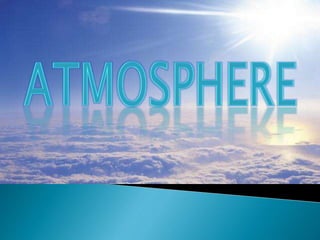Atmosphere
•Télécharger en tant que PPTX, PDF•
4 j'aime•825 vues
a presentation about the atmosphere.
Signaler
Partager
Signaler
Partager

Recommandé
Recommandé
Contenu connexe
Tendances
Tendances (20)
Similaire à Atmosphere
Similaire à Atmosphere (20)
Atmospheric Layers, Air Pressure, Weather Variables

Atmospheric Layers, Air Pressure, Weather Variables
Dernier
Dernier (20)
Sustainable Recovery and Reconstruction Framework (SURRF)(1).pdf

Sustainable Recovery and Reconstruction Framework (SURRF)(1).pdf
Cyclone Case Study Odisha 1999 Super Cyclone in India.

Cyclone Case Study Odisha 1999 Super Cyclone in India.
Test bank for beckmann and ling s obstetrics and gynecology 8th edition by ro...

Test bank for beckmann and ling s obstetrics and gynecology 8th edition by ro...
Enhancing forest data transparency for climate action

Enhancing forest data transparency for climate action
2,6-Dichlorophenol - Material Safety Data Sheet.pptx

2,6-Dichlorophenol - Material Safety Data Sheet.pptx
Research.pptxdfdddddddddddddddddddddddddddddddddddd

Research.pptxdfdddddddddddddddddddddddddddddddddddd
Introduction to heat waves and Heatwaves in Bangladesh.pptx

Introduction to heat waves and Heatwaves in Bangladesh.pptx
2024-05-08 Composting at Home 101 for the Rotary Club of Pinecrest.pptx

2024-05-08 Composting at Home 101 for the Rotary Club of Pinecrest.pptx
Training Of Trainers FAI Eng. Basel Tilapia Welfare.pdf

Training Of Trainers FAI Eng. Basel Tilapia Welfare.pdf
Yil Me Hu Spring 2024 - Nisqually Salmon Recovery Newsletter

Yil Me Hu Spring 2024 - Nisqually Salmon Recovery Newsletter
Yil Me Hu Summer 2023 Edition - Nisqually Salmon Recovery Newsletter

Yil Me Hu Summer 2023 Edition - Nisqually Salmon Recovery Newsletter
Russian Call girls in Dubai 0508644382 Dubai Call girls

Russian Call girls in Dubai 0508644382 Dubai Call girls
Disaster risk reduction management Module 4: Preparedness, Prevention and Mit...

Disaster risk reduction management Module 4: Preparedness, Prevention and Mit...
Atmosphere
- 2. is a layer of gases surrounding a planet or other material body of sufficient mass that is held in place by the gravity of the body. An atmosphere is more likely to be retained if the gravity is high and the atmosphere's temperature is low.
- 3. Composition of air The gases in Earth's atmosphere include: Nitrogen – 78 percent Oxygen – 21 percent Argon – 0.93 percent Carbon dioxide – 0.038 percent Water vapor and other gases exist in small amounts as well
- 4. Major Components of the Earth’s Atmosphere Gas Concentration Nitrogen, N2 78.1% by volume Oxygen, O2 20.9% by volume Argon, A 0.9% by volume Carbon dioxide, CO2 350 ppm Water vapor, H2O 0–4%, variable Ozone, O3 4–65 ppb Methane, CH4 1,750 ppb Carbon monoxide, CO 150 ppb Nitrous oxide, N2O 280 ppb
- 6. Troposphere - 0 to 12 km - Contains 75% of the gases in the atmosphere. This is where you live and where weather occurs. As height increases, temperature decreases. The temperature drops about 6.5 degrees Celsius for every kilometer above the earth's surface. ◦ Tropopause - located at the top of the troposhere. The temperature remains fairly constant here. This layer separates the troposphere from the stratosphere. We find the jet stream here. These are very strong winds that blow eastward.
- 7. Stratosphere - 12 to 50 km - in the lower part of the stratosphere. The temperature remains fairly constant (-60 degrees Celsius). This layer contains the ozone layer. Ozone acts as a shield for in the earth's surface. It absorbs ultraviolet radiation from the sun. This causes a temperature increase in the upper part of the layer.
- 8. Mesosphere - 50 to 80 km - in the lower part of the stratosphere. The temperature drops in this layer to about -100 degrees Celsius. This is the coldest region of the atmosphere. This layer protects the earth from meteoroids. They burn up in this area.
- 9. Thermosphere - 80 km and up - The air is very thin. Thermosphere means "heat sphere". The temperature is very high in this layer because ultraviolet radiation is turned into heat. Temperatures often reach 2000 degrees Celsius or more.
- 10. Ionosphere - This is the lower part of the thermosphere. It extends from about 80 to 550 km. Gas particles absorb ultraviolet and X-ray radiation from the sun. The particles of gas become electrically charged (ions). Radio waves are bounced off the ions and reflect waves back to earth. This generally helps radio communication. However, solar flares can increase the number of ions and can interfere with the transmission of some radio waves.
- 11. Exosphere - the upper part of the thermosphere. It extends from about 550 km for thousands of kilometers. Air is very thin here. This is the area where satellites orbit the earth.
- 12. Magnetosphere - the area around the earth that extends beyond the atmosphere. The earth's magnetic field operates here. It begins at about 1000 km. It is made up of positively charged protons and negatively charged electrons. This traps the particles that are given off by the sun. They are concentrated into belts or layers called the Van Allen radiation belts. The Van Allen belts trap deadly radiation. When large amounts are given off during a solar flare, the particles collide with each other causing the aurora borealis or the northern lights.